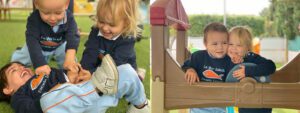How to Help Children Overcome Their Fears:
Fear is a natural and beneficial feeling for anyone, whether a child or an adult. As adults and especially those of us who are parents, we must not ignore or dismiss our little ones’ fears. Rather than causing us undue worry, our children’s fears should help us recognise a certain level of maturity in them. They reflect an emerging awareness shaped by their experiences and memories of unpleasant events.
Being afraid is a common experience for children. Fear is one of the most basic human emotions. In children, fears are developmental that is, they change depending on the child’s age. The key lies in learning to overcome them at the right time and age when they appear, preventing them from becoming stuck and avoiding the accumulation of fears as the child grows.
We usually talk about childhood fears appearing around the age of two, this is when a child’s imagination and fantasy life begin to play a more prominent role. However, this doesn’t mean that children don’t experience fears before that age.
At around one year old, most fears are related to separation anxiety, fear of strangers, and sudden loud noises or surprises.
Between the ages of two and four, common fears include animals, the dark, masks and costumes, and being separated from their parents.
Between the ages of four and six, fear of the dark and animals often continues, while new fears may emerge, such as fear of disasters, pain, blood, and imaginary creatures.
As adults, we often try to sheild children for fear out of the desire to protect them. However, this approach is not recommended, as avoiding fear simply pushes the issue aside and prevents children from developing strategies to overcome it. That’s why we mustn’t allow children to avoid fearful situations entirely. Instead, we should help them face these fears gradually, providing them with tools and simple techniques, always with a supportive adult by their side, someone they can look to for reassurance and a sense of safety.
Here are some strategies:
- It is essential not to scold them or force them to change their attitude.
- Minimise the importance of their fears, but without ignoring them.
- Show them affection, protection, calmness and confidence.
- Face the problem together with your child. When they are unable to do something on their own, try doing it with them so they can see there is nothing to fear. For example, if they don’t want to enter their room in the dark, hold their hand and go in with them.
- When your child is experiencing fear, try to distract them with games, but always tell them the truth. Sometimes it’s the unknown and lack of information that cause your child’s fears. If they get scared by stories about ogres, witches, and so on, explain that these characters don’t exist in real life and only live in stories and films.
- Help your child assess their own level of fear and provide them with strategies to gradually overcome it, such as deep breathing, thinking of pleasant things, and reminding themselves why they are safe.
At school, we work on emotions so that children can recognise them. Through motivating activities and resources, such as stories, plays, and play materials related to the topic—we help them channel their feelings in a positive way.
To conclude this article, I’d like to share one of the activities we do in the classroom. We have created a “fear box,” which we use to play guessing games with sounds and somewhat unusual objects. In a fun way, this helps children gradually overcome everyday fears.






